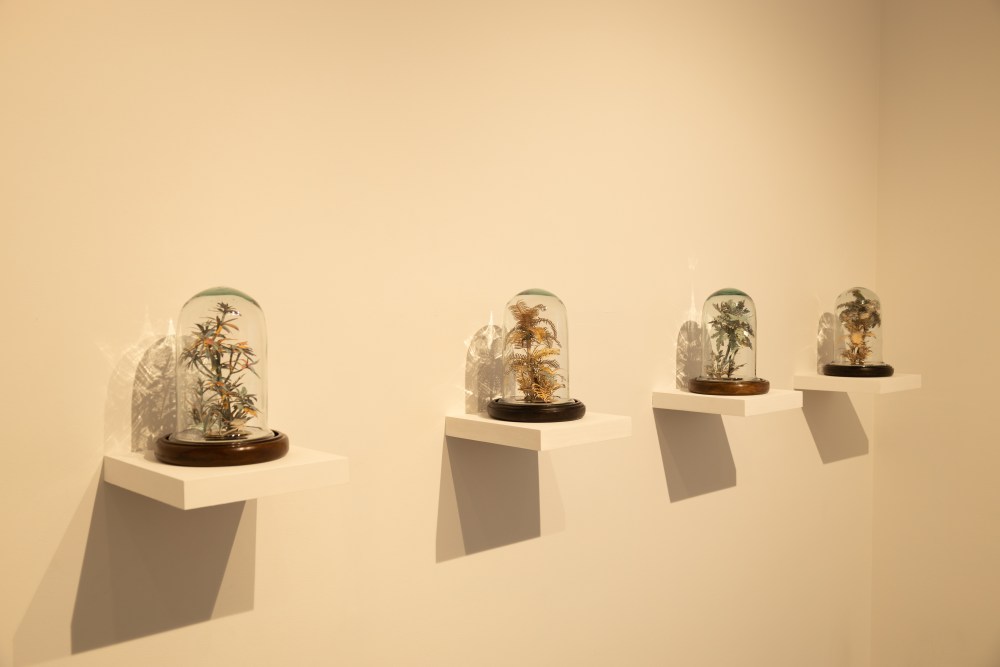Master paper sculptor Ryan Villamael embraces the fragility of the material in his practice to portray the complexities of the history of Filipino migration and his own family’s story. The Philippines-based artist creates delicate figurines of flora from maps that he then encases in bell jars as a means of drawing connections between nature, identity, and the Filipino diaspora. These works compose Villamael’s ongoing series Pulô (Tagalog for “island”), which is one component of his first-ever solo show in the United States, ISLES, at Silverlens in New York City. The second portion of the show is entitled Echoes of Home, which features an architectural blueprint accompanied by an audio recording of Villamael as a child.
Echoes of Home, 2024 watercolor on blueprint
Villamael elaborates on the ideas he’s grappling with through ISLES below.
Can you shed some light on your creative journey that has led you to where you are today?
My process has been shaped by the intersection of necessity, history, and identity. My earliest works were driven by practicality— paper was affordable and accessible, and I found that its fragility and versatility suited my desire to explore complex themes.
As my work progressed, especially with the Pulô series, which started in 2014 and I revisit once again in this show, paper became more than just a medium, it became a way to explore history, memory, and identity— themes that are both personal and universal. The act of cutting, folding, and layering paper mirrored the emotional and psychological layers of my own history, particularly my family’s experiences with migration.
The act of cutting, folding, and layering paper mirrored the emotional and psychological layers of my own history…
This show represents the past decade of my practice, exploring how history and identity are shaped by geography, power, and personal narratives. It’s a personal journey of reconnecting with the past while navigating my place in the present. Through my process, I hope to communicate the stories that are often hidden, both from personal and collective histories.
Left: Pulô series XVIII, 2024 paper (map replica); Right: Pulô series XX, 2024 paper (map replica)
Why paper? What initially drew you to the medium for your sculptures, and what about paper keeps you captivated to keep pushing the form?
Paper was initially a choice of necessity, but it soon became something much more. It’s an inherently fragile material— easy to manipulate, yet easily torn. This fragility appealed to me because it reflects the fragility of memory, identity, and history itself. In a way, paper is a metaphor for how we carry the weight of our histories, and how those histories can be fragmented, erased, or even reconstructed. As I worked with it more, I began to appreciate its depth and versatility, not just as a surface to mark upon, but as a material that can be sculpted, cut, folded, and layered in ways that reflect the complexities of what I’m trying to communicate.
Paper is a metaphor for how we carry the weight of our histories, and how those histories can be fragmented, erased, or even reconstructed.
Left: Pulô series XXI, 2024 paper (map replica); Right: Pulô series XXII, 2024 paper (map replica)
ISLES is a deeply personal show for you, in which you reflect on the Philippines’ history of migration and your own family’s story. Can you elaborate on these themes a bit more, and share what inspired you to mine this territory with your work?
ISLES reflects my deep connection to themes of migration, displacement, and the evolving idea of home. My family, like so many others, has experienced the emotional complexities of migration. This personal experience is at the heart of my work. In the exhibition, I explore how migration isn’t just a physical journey, but also an emotional one, shaped by memory, geography, and shifting economic and political forces.
The show also speaks to the collective experience of many Filipino families who migrate in search of better opportunities elsewhere. I wanted to create a space where my personal story could create a dialogue with others who share these experiences.
My own family’s migration story, shaped by the pursuit of a better life, is reflected in the works, particularly in Echoes of Home, where I blend a voice recording of myself as a child wishing my father a happy birthday, with the blueprint of a dream house our family never realized. This exploration isn’t just about longing for home, but about reconciling with the place that has shaped us, even when we’re no longer there.
Left: Pulô series XXV, 2024 paper (map replica); Right: Pulô series XXVI, 2024 paper (map replica)
How did the idea to create fauna sculptures from maps and place them in bell jars develop? What are you trying to communicate with this form?
The idea to create these soft paper sculptures from maps emerged from the historical use of maps to control territories, draw borders, and define geography. The Philippines, having experienced colonial rule from both Spain and the United States, has a long history of being shaped by external forces. By creating tropical flora from these documented expressions of colonial rule, and encasing them in bell jars, I wanted to communicate how nature endures despite human-made restrictions. Bell jars symbolize both preservation and containment, suggesting that while nature may be constrained, it continues to thrive— in the same way, identity and belonging can be shaped by external forces, but they also adapt and persist in the face of those forces.
Bell jars symbolize both preservation and containment, suggesting that while nature may be constrained, it continues to thrive.
There’s an auditory aspect of the show as well, featuring voice recordings exchanged between you and your mom, and sent to your dad while he worked abroad in the Middle East. What were you hoping this added dimension would bring to the show?
The recording comes from an old cassette tape I found in our house of my childhood self talking to my father, who at that point was working in the Middle East, as part of the generations of our countrymen who leave home to become Overseas Filipino Workers (OFW), in the hopes of a better life for their families.
These voice recordings, along with countless handwritten letters, were a common way for families to connect in the analog era before WhatsApp messages and FaceTime calls. During that time, tapes like this were flying out of the Philippines and sent all over the world. These tapes—these fleeting moments of connection—carried so much across great distances.
By adding the sound element to the exhibition, I aim to introduce a sense of intimacy and nostalgia, almost like opening a time capsule. It connects viewers to the emotions of migration— not just the physical journey, but the emotional labor of staying connected, remembering, and longing for a place and a person who may be far away, almost like speaking into a void.
Ultimately, I wanted to create an atmosphere where that shared experience of emotional distance could be felt and understood.
Through the sound, I hope to evoke the quiet yet persistent longing that many migrant families experience, especially during a time when we didn’t have access to the internet. Ultimately, I wanted to create an atmosphere where that shared experience of emotional distance could be felt and understood.
The post Ryan Villamael Portrays Personal and Collective Migration Histories in his Paper Sculptures appeared first on PRINT Magazine.

